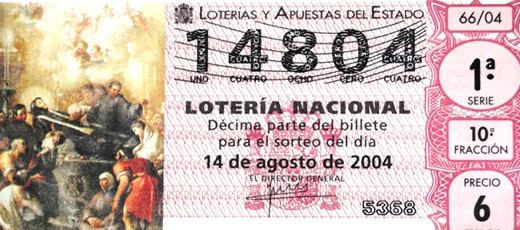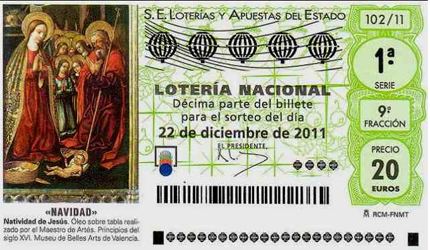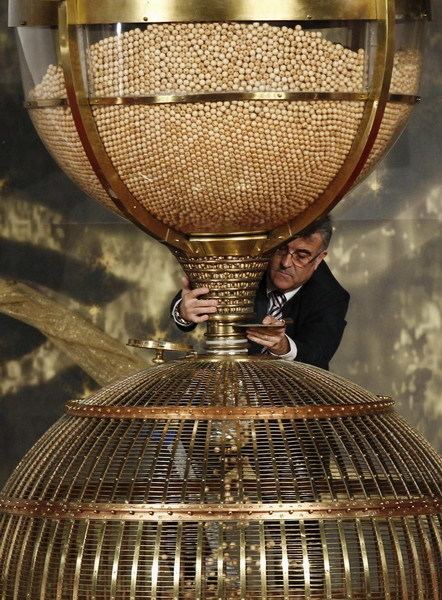 | ||
The spanish christmas lottery
The Spanish Christmas Lottery (officially Sorteo Extraordinario de Navidad [sorˈteo estɾaorðiˈnaɾjo ðe naβiˈðað] or simply Lotería de Navidad [loteˈɾia ðe naβiˈðað]) is a national lottery. It has been organized every year since 1812 by a branch of the Spanish Public Administration, now called Loterías y Apuestas del Estado. The name Sorteo de Navidad was used for the first time in 1892.
Contents

The Spanish Christmas lottery is the second longest continuously running lottery in the world. This includes the years during the Spanish Civil War when the lottery draw was held in Valencia after the Republicans were forced to relocate their capital from Madrid. After the overthrow of the Republican government the lottery continued uninterrupted under the Franco regime.

As measured by the total prize payout, the Spanish Christmas Lottery is considered the biggest lottery worldwide. In 2015, with 18 million pre-printed €200 tickets to sell, the maximum total amount available for all prizes would be €2.52 billion (70% of ticket sales). The total prize for the first place El Gordo ("the big one") jackpot would be €720 million.

Ticket numbers and prizes

Since 2011, the Spanish Christmas Lottery is based on tickets ("billetes") which have 5-digit numbers, from #00000 to #99999. Since this system only produces 100,000 unique ticket numbers, each ticket number is printed multiple times, in several so-called series ("serie"). The series is also identified on each ticket by a series number. In this way, the lottery organizer is able to sell more than 100,000 tickets each year, numbered from "Series 001 Ticket 00000" through "Series xxx Ticket 99999", where xxx is the total number of series printed in a given year.

For example, in 2015, there were 180 series of 100,000 tickets each, for a total of 18,000,000 tickets available at €200 each. If all €3.6 billion of tickets were sold, there would be €2.52 billion (70% of ticket sales) available for prizes.

Because the €200 ticket price may be prohibitive for many purchasers, each of the pre-printed tickets is actually a perforated tear-apart sheet of 10 identical sub-tickets ("décimos"), available for €20 each. Each sub-ticket is entitled to 10% of any prize that the ticket has won.
On a private basis, or through associations and other organizations, it is also possible to buy or be given even smaller portions of one ticket, called "participations". Many organizations buy tickets and divide them up and sell them as participations to their customers or employees. Usually, the price of those portions is increased by a small amount that is paid as a donation to the intermediary organization. Participations are made by writing the number and the amount paid, and signing it as proof of participation. If the ticket is a winner, anyone holding a participation will be entitled to their proportional amount of the prize payout.
Most Spanish people hold at least a small portion of a lottery ticket in the Christmas Lottery each year, even if they do not gamble during the rest of the year. This includes tickets exchanged with family and acquaintances, or participations sold by one's employer.
Using available data for 2013, when there were 160 "serie" of 100,000 "billetes" (from 00000 to 99999) at €200 each, the maximum ticket sales of €3.2 billion would produce a prize payout of €2.24 billion (70% of ticket sales). For each one of the 160 "serie", the prize structure would be:
In 2012 the €4,000,000 El Gordo was paid to ticket number 76058. The numbers 76057 and 76059 obtained the corresponding €20,000 approximation prizes. Additionally, all numbers between 76000 and 76099 (excluding El Gordo but including approximations) obtained the €1,000 prize for the numbers with the same first three digits of El Gordo. All numbers ending in "58" (excluding El Gordo) obtained €1,000, and all numbers ending in "8" (excluding El Gordo) obtained a refund of €200.
The exact quantity of tickets and series, and their prices, may be different each year. For example, in 2004, there were 66,000 different numbers in 195 series. In 2005, there were 85,000 numbers in 170 series, whereas in 2006 the number of series was increased to 180. Since 2011 there are 100,000 different numbers in 180 series. Distribution of prizes can change also, as in 2002 with the introduction of the Euro, or in 2011, when El Gordo increased from €3,000,000 to €4,000,000, the Second Prize increased from €1,000,000 to €1,250,000, the Fifth Prizes increased from €50,000 to €60,000, and 20 more pedreas of €1,000 were added. In 2013 the number of series has been reduced from 180 to 160 to adjust to the expected demand.
The draw
Since December 18, 1812, the Christmas Lottery drawings are held according to exactly the same procedure each year. In the past it took place in the Lotería Nacional hall of Madrid, while in 2010 and 2011 it was celebrated in the Palacio Municipal de Congresos de Madrid, and in 2012 in Teatro Real in Madrid. Pupils of the San Ildefonso school (formerly reserved for orphans of public servants) draw the numbers and corresponding prizes, delivering the results in song to the public. Until 1984, only boys from San Ildefonso participated in the drawing; that year Mónica Rodríguez became the first girl to sing the results, including a fourth prize of 25 million Spanish pesetas. It is a custom that the winners donate some of the money to the San Ildefonso school. The public attending the event may be dressed in lottery-related extravagant clothing and hats. The state-run Televisión Española and Radio Nacional de España, and other media outlets, broadcast the entire draw, which currently takes place on December 22 each year.
Two spherical vessels are used. The big one contains 100,000 small wooden balls, each with a unique 5-digit number on it, from 00000 to 99999. The small vessel contains 1,807 small wooden balls, each one with a prize in Euros on it:
Inscriptions on the wooden balls are nowadays made with a laser, to avoid any difference in weight between them. They weigh 3 g and have a diameter of 18.8 mm. Before being thrown into the vessels, the numbers are shown to the public for anyone to check that the balls with their numbers are not missing.
As the drawing goes on, a single ball is extracted from each of the revolving spheres at the same time. One child sings the winning number, the other child sings the corresponding prize. This is repeated until all the prize-balls are connected to a number. Due to the sheer number of prizes, this procedure takes several hours. The children work in about eight to nine shifts, equal to the number of frames of numbers to be drawn.
The balls have holes on them so they would be slotted into wires in frames for later presentation. When a major prize is drawn, both children repeat their singing multiple times, and show the balls to a committee, and then to a fixed camera with two Phillips screwdriver heads mounted at the front, all before being inserted into a frame as the others. Although the drawing is by chance, the children who draw the higher prizes are applauded. Apart from the prizes drawn from the vessel, some prizes are calculated from the winning numbers (view the table with prizes above).
The two-vessels system was the traditional one in Spanish lottery, but now it is only used in the Christmas Lottery. The rest of the weekly and extraordinary draws during the year use five vessels with ten balls each (numbered 0 to 9), from where the five digits of the winning numbers are drawn.
The odds of just evening out the costs are of 10% (by matching the final digit), while chances of winning more money are about 5.3%. The prize structure makes it easier to win some money compared to other lotteries, and it is common saying that the prizes of the Christmas Lottery are well distributed all around Spain. Chances of winning El Gordo are 1 in 100,000, that is 0.001%, while chances of winning the top prize of EuroMillions are 1 in 116,531,800 or 0.0000000086%.
Non-winners will make the commonplace comment that "it's health that really matters". Those who just get their money back will often re-invest the prize in a ticket for Sorteo de El Niño, the second most important draw, held before the feast of Epiphany of Jesus on January 6.
El Gordo
The climax of the drawing is the moment when El Gordo is drawn. Lottery outlets usually only sell tickets for one or two numbers, so the winners of the largest prizes often live in the same town or area or work for the same company. In 2011, El Gordo was sold entirely in Grañén, Huesca, a town with about 2,000 people. In 2010, €414 million from the first prize were sold in Barcelona, and the rest of the €585 million of El Gordo was distributed between Madrid, Tenerife, Alicante, Palencia, Zaragoza, Cáceres, and Guipúzcoa. In 2006, the winning number was sold in eight different lottery outlets across Spain, while the second prize number (€100,000 per décimo) was only ever sold from a kiosk on the Puerta del Sol in central Madrid. In 2005, the winning number was sold in the town of Vic in Catalonia (population 37,825), whose inhabitants shared about €500 million (€300,000 per winning décimo).
As a misconception in many non-Spanish speaking countries, it is often assumed that the term El Gordo is specific for the Christmas Lottery; some even think that El Gordo is in fact the name of the lottery. However, the real meaning of El Gordo is simply "the first prize" (literally "the fat one" or more accurately "the big one"); other lotteries have their Gordo as well. To add to the confusion, there is a relatively new weekly Spanish lottery game called El Gordo de la Primitiva, which has nothing in common with the Christmas lottery, except the fact that it is organized by the Spanish public lottery entity Loterías y Apuestas del Estado.
